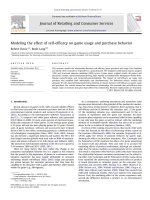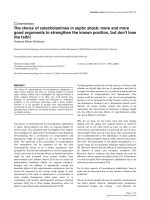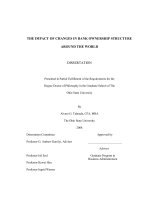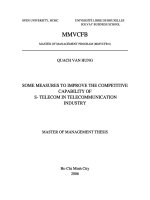THE STATUS OF CARD SERVICES BANK BRANCH BIDV AND PROPOSED SOME MEASURES TO IMPROVE SERVICE QUALITY CARD
Bạn đang xem bản rút gọn của tài liệu. Xem và tải ngay bản đầy đủ của tài liệu tại đây (666.79 KB, 109 trang )
THE STATUS OF CARD SERVICES BANK BRANCH BIDV AND
PROPOSED SOME MEASURES TO IMPROVE SERVICE QUALITY
CARD
INTRODUCTION
1.The urgency of the subject
Can
be
confirmed,
an
important
part
of
the
marketing
strategy
is
distributed. Resolve the distribution system to deliver goods and services to
consumers like. Distribution system to create the smooth flow of each product from
banking services to customers, improve the exchange relationship between the bank
and customers on the market. This is a problem most of the bank executives
interested.
For the Bank's card products (BIDV), is a kind of new products, modern BIDV
officially launched operations in 1997 as a payment agent Visa and MasterCard for
UOB bank in HCM City , after 10 years of operation, the Bank has obtained a
certain result and initially confirmed the location of the NH in VN card market. In
the course of operations, the Bank was interested in the development of card
distribution system.However, the results were not really satisfactory, inadequate and
need to develop effective solutions to card distribution system, contribute to
improving the competitiveness of card products BIDV .
Derived from practice, I have chosen the theme: "Development of card distribution
system at BIDV" master's thesis.
2.Research purposes
System, analysis and commentary to clarify the basic theoretical issues
about card distribution system of commercial banks, the proposed system solution
developed distribution channels in BIDV card.
3. The object and scope of the study
Cards are large problems, the thesis research focused on card distribution system,
for practical distribution system cards at BIDV from 2001 to 2007 as the basis of
evidence
4. Research methodology.
Thesis using research synthesis methods: dialectical materialism, historical
materialism, methods of analysis, synthesis, inductive, statistical method,
comparative method, retrospective documentation of the previous research and the
actual survey questionnaire.
6.Scientific contributions of the thesis
−
Clarify the basis of a review of the card distribution system Development in
the Commercial Banks
−
Underestimated card distribution system at BIDV, indicating the presence and
limitations of the distribution system cards at BIDV
−
BIDV
Proposed a number of solutions to development card distribution system at
7. Structure of the thesis
In addition to the introduction, conclusion, list of references, the content of the
thesis is structured into three chapters:
Chapter 1: The basics of card distribution system of commercial banks.
Chapter 2: Status of card distribution system in the Bank.
Chapter 3: System solutions developed distribution channels in BIDV card.
.
CHAPTER 1
BASIC
PROBLEMS
OF
SYSTEM
CARD
DISTRIBUTION
OF
COMMERCIAL BANKS
1.1 OVERVIEW OF BANK CARD TRANSACTIONS
1.1.1 The formation and development of the Bank
Social reproduction process always takes place on an ongoing and constantly
evolving, in the course of which there are many relationships between the subject of
the production, especially the relationship traded goods . Therefore, the payment
institution in the relationship of the production process is important and necessary
contribution to the development of the social productive. From ancient times to a
few hundred years ago the precious metal acts as a medium of exchange in all
societies. The problem occurs with the payment system based entirely on precious
metals is that this money is very heavy and difficult to move from one place to
another. The continued development of the payment system is paper money. At first
paper money may be converted to coins. However, in most countries, it has evolved
into fiat money, not able to be converted into coins. Paper currency benefit is that it
is much lighter than coins or precious metals; constraints of paper money and coins
that they can easily be stolen and expensive to transport due to cumbersome.
To overcome this difficulty, a new progress payment system appeared with modern
banking activity: it is the birth of a check. The use of checks has reduced
transportation costs associated with the billing system and improve economic
efficiency. Benefits of checks they can write any amount of money for the rest of
the balance on the account makes dealing with large amount of easy, bring
convenience in the collection of funds and the ability to take greatly reduced
theft. However, obstacles to check takes time to move from one place to check,
bank time to check and credited to your account, moreover, the use of checks
having a lot of trouble with complex magazine papers.
Along with the development of science and technology, an e-payment system in
which the use of papers will minimize being developed. Next check is the
development bank payment cards, dating from the first decades of the 20th century,
developed from the 70s and has become a popular tool in this day and age.
Cards first appeared in 1914 when the California Petroleum Corporation (the
company that today is the Mobil) conducted cards for the staff and a number of its
customers. The basic purpose is to encourage sales of the company, not
accompanied by a provision regarding the extension of credit. However, the new
bank card technology actually began nearly 50 years ago, in which the relationship
between customer and vendor relations center. When a business wants to expand
their credit to its customers, the customer is allowed to debit their account.
Form is the first bank card Charge-it, a credit system developed by John Biggins in
1946, allowing customers to make purchases at retail locations. The business in
Biggins banks and deposit banks collect payments from customers and return
business. This system was prepared for the first credit card in circulation in 1951 in
New York issued by the Franklin National Bank.
There are many types of cards have been used around the world, typical of them to
mention the cards held by the prestigious international release, including Diners
Club, Amex, Visa, JCB and MasterCard.
Diners Club card, first released in 1949, with an annual fee of $ 5.Diners Club
cardholder can debit going to eat at 27 restaurants located in or along the New York
City. Diners Club initially be used to pay for meals at the restaurant, but then
gradually become travel and entertainment cards are present all over the
world. 1960 is the first card in Japan, the branch is managed by Citi Cop. At this
time all over the world, only about 1.5 million Diners Club cards in circulation with
a turnover of 7.9 billion USD. In 1990, this number up to 6.9 million cards and
sales of $ 16 billion. Following Diners Club, is the appearance of a series of
uniform cards with it like Trip Change, Golden Key, Guest Club ... At first the
majority of cards issued by large companies, until the bank realized the superiority
of using the card and a huge market in the future, then quickly enter the field of
bank issuing card.
Figure 1.1 history of ATM Card
Amex card is the abbreviated name of the American Express card issued by the
American Express card in 1958 with a total of 5 times Diners Club.If you stand in
terms of tourism and recreation, annual Amex card is the most preferred by
customers, with the largest revenue in this area with 3 cards mainly Amex Gold and
Amex Platinum and Amex Optima. In 1973, when the U.S. economic crisis broke
out, the turnover of Amex remains at 8% / year. In the three years from 1990 to
1993, revenues increased from $ 111.5 billion to $ 120 billion, the number of cards
in circulation increased from 35.4 million to 36.5 million, with over 3.6 million
cards merchant base (CAU ) payment. Unlike other cards, Amex card itself own
and directly manage cardholders, whereby they grasp the necessary information
about customers to develop programs such as customer classification to provide
service provider.
Visa card issued by Bank of America in 1960, originally named Bank
Americard.The Bank of America itself is an affiliate association of banks in the
U.S. states, so it has wide distribution network. In 1977, Bank card Americard
officially changed its name to Visa, were present throughout the world and is
known as card-scale development in the world. By the end of 1990, about 257
million cards in circulation revenue of about $ 354 billion. In late 1993, Visa's
revenue grew strongly up to $ 542 billion. Visa ATM systems around 164,000
ATMs in 65 countries around the world. Visa card is not directly transferred to the
unit members, as well as favorable conditions for Visa easier to market expansion
cards. Visa now has more than 22,000 affiliates in more than 200 countries, has
released more than 500 million cards, more than 13 million merchant payment,
320,000 cash dispensers, sales of $ 800 billion in annual transactions.
JCB cards are cards came from Japan in 1961 by San Wa bank, in 1981, began to
develop into an international basis.Main goal is to focus on the tourism and leisure
market, is to compete with Amex. JCB card, the Japanese have proven card
technology is no longer the absolute monopoly of the American organizations. If
1990 JCB card sales of $ 16.5 billion with 17 million payment cards in circulation
are accepted at more than 400,000 locations in 109 countries outside Japan;, to
1992, with over 30 million cards, 2 , 9 million merchant and 160,000 ATMs in 139
countries with revenues of $ 30.9 billion. Today JCB is strong rise on par with other
cards.
MasterCard card is launched in 1966 under the name MasterCharge by bank card
association ICA (Interbank Card Association) released through members around the
world.In 1979, MasterCharge was renamed MasterCard payment card and become
the second largest in the world after Visa. So far the number of members
participating in MasterCard card associations have up to 29,000 members in more
than 200 countries, issued 350 million cards, 12 million merchant payment, 200,000
ATMs, sales transactions in about 460 $ t5y.
Today, MasterCard and Visa are the two most popular cards used in the world. Card
increasingly diversified and became very popular products. During 80 years of card
transactions increased by 20% annually. With these utilities provide bank card has
become a major means of payment of all strata of the population in developed
countries and the developing world.
1.1.2 The concept of bank card
From the perspective of considering different studies, we launched the concept of a
different payment card. In the opinion of the State Bank of Vietnam (SBV) Vietnam
(Regulation issued, used and bank card payment issued under Decision
371/1999/QDNHNN1 date 19/10/1999 of the Governor of the State Bank of
promulgating the regulations issued, and use the bank card payment): Bank card is
a means of payment for goods and services can not cash or cash at the cash machine
automatically or the agent bank.In other words, the bank card is a non-cash payment
means that cardholders can use to withdraw cash or pay for the purchase of goods,
use services at the POS
In terms of release, the card is a means by banks, financial institutions or other
issuers for transactions of goods, services or cash.
From a technology perspective the payment card as payment method e-book
amount of the payment transaction needs, made on the payment system is connected
between the actors, based on banking technology and telecommunications. It allows
payment transactions in a convenient, safe for the participants pay.
From the above analysis, it can be concluded that: payment card is an electronic
means of payment issued by a bank / issuer, allowing cardholders to use to pay for
goods or services to withdraw cash within the amount on the customer's account or
credit card.
1.1.3 Structure of the card bank
From the beginning of time, the card is made of metal, through the selection
process, so far most of the cards are made of hard plastic (Plastic) with normal size
is 95mm x 55mm x 0.76 mm, 3 layers: the core card is a plastic layer in the middle
and two layers of rolled plastic sides. Depending on the method of access and
management of information processing card that is made from strips of tape (credit
card) or integrated circuits (chips) recorded data (chip card) or magnetic tape, Chip
(card from Chip).
The front of the card typically includes (see Figure 1.2):
-
Background, color cards, depending on the bank chosen and depending on
the card type prescribed by the issuing bank.
-
The name and logo of the issuing banks, card organizations badge and logo
of the organization, such as MasterCard, Visa, AMEX, Diners Club, JCB ...
-
For the chip, the chip will be arranged on the front.
Number of cards: Each card is assigned a separate number to manage
subject to the provisions of international card organizations, or the issuing bank.
-
The effective date of the card: embossed on the card
-
They cardholder name, company name (if corporate card)
-
The security element of the card organizations
Figure 1.2.Eye tric and after CNA Visa
Biểu tợng của
TCTQT
Số thẻ đều nhau.
Họ tên chủ thẻ
Mặt sau của thẻ VISA
Dải băng từ tính
ô chữ k
Nguồn: Ngân hàng BIDV Việt Nam
The back of the card include:
-
Tape strips (for credit card): the ability to store the following information:
card number, effective date, the name of the issuing bank, the cardholder name,
effective date, cardholder's personal identification number (PIN)
-
Oh signatures: for a sample signature card to card-accepting unit (CAU)
when using test.Currently, card printing technology to print the signature on the
front of the card.
-
Some guidelines for cardholders, contact phone ...
1.1.4 Classification of bank card
Bank card is really very rich and diverse, are used for many different
purposes. Based on various criteria that bank cards are classified
- In terms of production technology, it is divided into braille engraved card,
magnetic stripe and chip card:
•
Braille engraved card (Embossing Card): The original early card, the basic
information is relief on the card.This card is now no longer used by poor security,
ease of counterfeiting.
•
From card (Magnetic stripe): Card is covered with a bandage with 2 or 3
strips of coded information relating to clients such as: fixed information about the
cardholder and the card number, the expiry date of the card, name card holder ...
•
Chip card (Smart Card): Card is produced based on microprocessor
technology.The front of the card is attached to an electronic chip on the principle of
handling such a small computer. This is the latest generation, the most modern of
the current card, overcome the drawbacks of the card from a high security safe.
-
Payment terms of the nature of the card, it is divided into debit and credit
cards:
•
Debit card (debit card): A type of card has a direct relationship and
connection with your customers' deposits.Every time a transaction is made, the bank
will automatically deducted at the corresponding amount on the cardholder's
account.
•
Credit Cards (Credit card): Credit Card payment to a certain spending limit
that banks provide to users on the basis of financial capacity, security deposit or
collateral.
-
In terms of the subject issue: payment cards often include cards issued by
banks, due to the non-issuing banks, card association between bank and non-bank
institutions.
-
In terms of the cardholder: There are two types of cards are personal and
company cards.
•
Individuals: a card by individuals requesting Issuer card and use the card on
limit level or the balance on the card account.
•
Card companies: the companies recommended Issuer cards to individuals
authorized legal representative of the company to use the card.The company is
responsible for paying the expenses of the individual card.
- In terms of territory use: Card card is divided into domestic and international
cards.
•
Debit card: This card is only used within a country, as a result, the currency
used to purchase and sale of goods or cash to local currency.
•
Card: This card not only within the country but also accepted widely used
worldwide.Bank to issue these cards must be a member of the international card
organizations such as Visa, MasterCard, Amex, JCB ...
1.1.5.The role of service development card
1.1.5.1
For the economy:
- Reduce the volume of cash in circulation:
Means of non-cash payments, the first role of the card is to reduce the volume of
cash in circulation.Thus, the costs related to transportation, cash counting, mass,
pressure on cash, counterfeit money in circulation decreased significantly.
- Increasing the volume of turnover, payment:
Most card transactions within the national or global level will be done online
(online), the rate cycle, payment transaction much faster than through other means
of payment such as checks, authorized to collect, authorized payment ...
- Contributing financial transparency, support macroeconomic management
policy of the State:
In card payment transactions are done through banks. With modern technology, all
transactions are within the bank's ability to control and create the foundation for the
work of the State's macro-management, implementation of national monetary
policy, reducing the negative impact of underground economic activities.
- Implement measures to "stimulate" the State:
Card which brings convenience to users, Merchants, banks make more and more
popular card use, increase spending and create a new consumer trend "consumer
first, pay later "lead to increased consumer demand. Thus, the card has become a
useful tool contributing to the implementation of measures "stimulus" of the State.
- To contribute to improving the environment of civilization, to promote
international tourism and foreign investment:
Card payments to reduce the transactions manually, access to a payment of world
civilization. Along with the process of international economic integration Vietnam
deeper wave of foreign tourists and investors access to the growing Vietnamese
market. The card development will help meet the needs of foreigners, eliminate the
pay gap between Vietnam and the world.
- To promote e-commerce development:
Is the primary means of payment cards of e-commerce transactions.The
development of electronic commerce depends largely on the method of payment, in
order to ensure the speed factor, safety and security. Therefore, the card payment
services growing, e-commerce since then as conditions develop and perfect.
1.1.5.2 For the bank
- Increase of capital and profits for the Bank:
Card activity grows, the amount of customer deposits to increasing card payments,
giving the bank a substantial amount of capital in cash, can be considered a source
of profit for the bank.In addition, payment and distribution activities as well as
business cards bring income to the bank through service charges: revenue from
merchant fees, distribution charges, charge cards, charge credit limit, interest rates
for credits which payment cardholder slow, cash advance fees, service charges
related ...
- Empowerment of the bank:
In addition to business performance including card services also bring intangible
benefits to the bank as: empowerment of the bank, to promote the brand image and
drag the customers to the bank ...
- Diversification of banking, risk diversification:
Card launched to enrich the banking, gives the bank a multi-utility payment, risk
diversification in the business activities of the bank. In addition, the card service
relationships also support other banking services, such as electronic banking (ebanking), the purchase of the business operations over the network ...
1.1.5.3
For cardholders
- Convenience, flexibility and time savings in the payment:
The flexibility and convenience of the payment in the country as well as abroad is a
utility that highlights the use of cards, so card users do not need to carry large
amounts of cash with you and still young payment of goods and services and
withdraw cash when needed 24/24h; 7 days a week. Since then, it has contributed to
the habit of using non-cash payment facilities in residential areas.
In addition, card services also save time to cardholders when shopping for avoid
sewn counting money when paying large sums of money, control spending through
the bank card account statement.
1.1.5.4
For Merchants
- Increase business efficiency:
Quick help card merchant acceptance of return. Merchants will be credited to your
account as soon as the card transaction data is transmitted to the bank or the
merchant submits bills to the bank card. Merchants will be entitled to non-term
interest rates to maintain balance on the bank card payment account. The merchant
also help the merchant to attract more customers using the card; leads to increase
sales at the same time significantly reducing the cost of sales as: counting,
preservation of money, financial management ...
- Safety and security: The acceptance of payment cards help CAU reduce the risk
of receiving counterfeit money, stolen money risk ...
- Shorten time dealing with customers:
When cash transactions, cash register, book-keeping is very complex. Card
transactions when done in EDC devices, simple operation, licensed processing time
for transactions only takes 10-25 seconds, which is very convenient for both the
customer and the merchant.
1.2 DISTRIBUTION SYSTEM of commercial banks.
Distribution strategy of products and services is considered as a central component
in the marketing mix strategy, including channel distribution is a distribution tool
market products and communicate effectively.Develop a strategic product, good
service, reasonable price strategy is not enough to ensure success in the banking
business, which requires managers to plan marketing distribution strategy to put the
bank's products and services to customers in the best way. This will be an important
event to promote the most effective of the two strategies. Thus, determining the
appropriate distribution system is extremely important issues but it is very
complicated, because it involves so many marketing activities, influence activities
and results of operations bank. Therefore, today the bank is interested in the
improvement and development of distribution system and see it as an advantage
factor in the modern banking business. Card is a new products and services of the
bank, to "knock" each customer in the use of the card, the bank has used a variety of
distribution channels, however popular and effective in a certain channels. In many
cases, the idea of multi-channel management has not been done in a coordinated
and unified. However, the development of card distribution system must be set out
as the leading strategy to put the card into one of the main business activities of the
bank.
1.2.1Characteristics of the channel bank card
Distribution channels can be understood as a set of organizations and individuals
and facilities involved in the process of bank card supply to customers.
From understanding the distribution channel can see NH card has the following
basic characteristics:
-
Channel card NH diversity and abundance, by the involvement of many
factors such as human, material and technological conditions.Therefore, the quality
of the channel depends on the quality of the above factors.
-
Channel distribution channel bank cards are usually short, and broad market
coverage
1.2.2 The structure of the distribution channel bank card
Channel card NH mainly three members:
- Bank card service providers (supply NH DV card).
- Intermediate: branch or agent.
- The consumer (the cardholder).
1.2.2.1. Supply bank card DV:
DV supply bank card is a bank State Bank of Vietnam (SBV) allows issuance and
payment cards; if you want to release and international card payment, the official
must be a member of the international card organizations.NH card service provider
shall receive dossiers of application for the card, card account processing and
management, and is responsible for international payment cards, card payment
service provider at Merchant . To the issuance and payment cards bring high
economic efficiency, there must be a reputable bank in the country as well as
internationally. NH card service provider shall:
- Consider the card issuer to the cardholder, guide the cardholder using the card and
regulations in the course of using the card.
- Deduction directly to the account holder transactions arising reduce deposit
balance or limit card account, and credited to this account when cardholders pay
more money.
- Signing of contract management and monitoring activities approved merchant card
payment, payment in full transaction amount after deducting the fees banks
receive.
1.2.2.2. The intermediary:
The middleware is an important member in the channel.The main
characteristics that make up the different characteristics of each type of channel. For
card distribution channels, there are two main types of intermediate branches and
agents make two specific type of card distribution channel is direct and indirect.
The branches are usually available or NH can actively open new bases
practical needs as well as their abilities.As for agents, each bank has its own
approach (based on the relationship, or in the form of promotions, etc.) to attract
and persuade the agency contracting units on the basis of cooperation mutually
beneficial.
1.2.2.3. Cardholders
Cardholders be the person named on the card issuing bank to
use.Cardholders may be a single individual or personal representative of a company
or organization that needs to use payment cards. Cardholder is the only person who
has the right to use your card to withdraw cash at an ATM or pay for goods and
services at the merchant. Cardholders are responsible for:
- Storage card to tell others not to steal or abuse.
- Use the right purpose.
- Must be at risk of losing money by PIN or counterfeit cards.
- To be responsible for the payment, refund used.
- When the loss must immediately notify the Issuer.
Issuing three types of channel members are involved in the process of "buying and
selling" services to members of the front and rear channels. Each member can
features and individual objects but the result is the emergence of a particular
channel consists of a mixture of power, conflict and cohesion.
Power in the channel is the ability of one member affect the operation of other
members, this means dynamic range.Learn the power of the channel firstly identify
which member is the decision maker on all matters related to the organization as the
number of channel members, the function of each member, and media technology
material used ... In fact, power is often shared, members have the power to channel
distribution at different levels. Strong power often focus on the more powerful
members, but they also dominated from the other elements in the channel.
Conflict and links: Conflict and links co-exist in most of the channels.So for card
distribution activities, the members must be linked together to create the
relationship between the members of the channel:
- The relationship between supply bank card DV intermediate and often emerging
conflicts of power and interest in distribution. The balance of power between banks
and agents in the bank decided the basic elements of service delivery card (price,
scope of use, level of service is done).
- The relationship between intermediaries and customers less conflict, the level is
not intense. Both have their own advantages and can force the enemy to perform
certain requests.
- The relationship between bank card service provision and customer is the indirect
relationship between the producer and consumer. NH card service provider is to
satisfy the customer's needs at the same time when using the services of the bank
card, customers have returned to banking information to know the effectiveness of
the services provided to the Project completion products and services, further
increases the income for the bank.
Besides the relationship always exists a conflict between members of the same
channel system. These are two sides of the same process. In each task, each member
to determine its position in relation to conflict - cooperation. Synthesis of all these
relationships is the reason to stick the channel members together make up a
complete card distribution system and science.
The channel members often talks about the specific functions they will
perform. Sometimes conflict occurs, break the relationship between the channel
members. Of course, the bank card service provider can remove a certain
intermediate but can not eliminate the functions that it performs. Thus, all channel
members to perform the following main functions:
- Market research: to gather the necessary information about supply and demand in
the market from card distribution strategy accordingly.
- To promote the expansion card products: this is the special work required for new
products, new to many people used to using cash.The card distribution channel
members need to prepare and disseminate information on the card to the customer.
- Negotiating: to income distribution agreements and interest in the channel.Agree
with each other on price and delivery conditions.
- Card Distribution: transportation, storage and place the card in the hands of
customers.
- Establish relationships: building and maintaining relationships with potential
buyers.
- Complete card products and services: making card services meet the requirements
of the buyer, that is, perform a the Card Issuer work.
- Funding: financial support mechanism for members in pay channels.
- San exchange risk: risks related to the distribution process.
The
question
is
reasonable to divide
these
functions among channel
members. Principle to divide the functions of specialization and division of labor. If
NH card service providers perform these functions, the cost will increase and prices
will be higher than the transfer of some functions to intermediaries. Therefore, the
issue of concern is who perform the work of the channel will make for higher
productivity and efficiency.
1.2.3 The role of distribution channel card
Card distribution channels means of direct bank card services to
customers.Thanks to the distribution channels that bank card services done quickly,
to meet the needs of customers. Distribution channels play a positive role in
improving, perfect card services, creating favorable conditions in the supply of bank
card services to customers. Cards is a modern means of many facilities with
affordable but to be able to customers, clients preferred cshuong and use it, there
must be a distribution system expansion cards, flexible and effective. Modern
products are distributed by a channel system science is a tool not only to create the
differences, but also expand the bank's image in the market
1.2.4 Factors affecting the distribution channels in the bank card.
1.2.4.1 The development of the market.
Today, the competition has become a rule of all economic sectors, takes place in
each branch, department, individual products and services at anytime,
anywhere. Products and services nascent bank card can not be located outside the
law. Along
with
the
development
of
competitive
markets,
and
the
internationalization trend is increasing. Moreover, a diversified banking products
should more pressure on profits and hence increase. Therefore more and more
banks plan l Select the product distribution channels in order to maximize profits.
1.2.4.2 The requirement of customers
Customers have come to bank card services bank means that they need to meet their
needs. Often customers looking for bank card services in the following
requirements:
- Search the income from bank card services through deposits receive the product
on a card account.
- Ensure safe management of assets (money).
- Convenient and payment transactions.
- Transfer of currency (bank transfer).
- Consulting expertise.
- Find out information.
Due to the growing demand more, so the card products and services to customers in
many different ways essential nature, the basic thing here is to find the appropriate
way, scientific learning and more effective.
1.2.4.3 The level of team work card distribution
Man is always the deciding factor for all activities in the economy, especially in the
card distribution process requires highly standardized, ensuring a smooth, uniform
in all phases of process. A tag team work with professional, knowledgeable
professional is a prerequisite to develop service delivery channels. On the other
hand, is a service of the bank card should have a team working on flexible payment
cards, dynamic, knowledgeable customer psychology.
1.2.4.4 Information Technology
The scientific and technical achievements require continuous investment in product
distribution channels associated with modern technology. Thanks to this system,
customer requirements can meet without the involvement of people with a role as
an intermediate component. The latest scientific and technical achievements allow
customers to use multiple ability that previously could not be performed.To get a
system to ensure extended service card at a high technical level requires banks and
other credit institutions need to have a large investment, and application of science
and technology in system development channel bank card services.
1.2.5 Types of distribution channels in the bank card
Currently, in the field of card services have two types of distribution channels are
mainly direct channel and indirect distribution channels.
1.2.5.1 Direct Distribution
Direct distribution channel is the channel in which banks use the branch network as
an intermediary to provide card services to customers. Therefore, the direct
distribution channel card is the bank's branch network.
Branch is a traditional channels associated with the system headquarters and
facilities in certain locations. Especially the provision of products and services the
bank card mainly made by bank staff. Therefore, the use of this channel often
requires a team of employees and customers to the transaction at the head office or
a branch transaction. Therefore to provide more card products and gain market
share, banks often develop extensive branch network and are always ready to
supply products to the bank. In fact, many banks have used a branch of duty card
distribution.
a. Organizations distributed cards at the branch:
supply Place the card and transaction-based branch of
Is a very important factor because the head office and a branch of the transaction
must be placed in a convenient location such as populated areas, near commercial
centers, major town ... will bring many benefits for banks. However, the selection of
a suitable place of business is not easy. If placed near the head office, head office or
trading room of a branch with a banking system or a branch of a commercial bank
has an advantage over or placed in an appropriate place will make it difficult for
card distribution activities.
Card products are provided at the branch
Might say, a branch bank is a living cell, is a miniature of the whole system, so it
can provide all kinds of bank card products. However, depending on the specific
characteristics of each region, depending on the business strategy of each different
bank branches can supply various card services to make up the rich, diverse form at
the same time there is a specialization in the provision of products and services
card.
Equipment at the branch.
Usually a branch arranged a number of major equipment such as: computers, laser
printers, UPS, safe, trading desk, generator, counter, cabinet documents, signage,
ATM.
Also in the process of implementing its functions, the branch also uses a lot of
physical clues and supporting technologies such as pen and paper, automobiles,
buildings.
Staff
Staff dealing directly with customers, the bank's image. By impression with
customers during transactions, employees involved in the sales promotion card
services. Therefore, the branch teller not just solid professional qualifications, but
also should have a courteous style, enthusiasm and openness, absolutely avoid a
cold attitude and too rigid. In addition, employees also need to be sensitive to
receive and convey information from market signals, from the client to the bank
executives.
Opening Hours
It is also an important factor for effective branch operations. Opening hours to
create favorable conditions, in accordance with the hours of the customers,
especially the group of customers was chosen to satisfy the needs of them. There is
so new to attract the largest number of customers.
b. Advantages and disadvantages
Pros
- Type of card distribution channel system branch has relatively high
stability. Before the products, the bank has built extensive branch network to
provide the products and services before, so the initial cost to build a new branch
service delivery is very little card. Born card services complement and enrich the
list of products and services are provided at the branch, thereby increasing income
for the bank.
- Our employees are professional bankers understand, so could well be propaganda,
guidance and service to attract customers to the card.
- Card service life, distributed through branches will take advantage of existing
relationships with customers, so the card distribution process easier.
- Activities of the branch system is relatively safe, easy to create the image of the
bank for customers.
- Branches are often easy to attract customers and satisfy the specific requirements
of customers.
Cons
- Works of passive because banks always have to call customer transactions at the
bank.
- If you have to invest in building new branches to expand the scope of supply,
investment costs are often large and requires a large campus, convenient
transaction.









